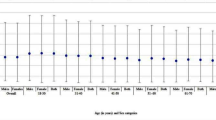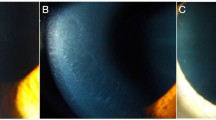Abstract
Purpose
To analyze and compare corneal endothelial mosaic in terms of endothelial cell population, morphology and irregularity in patients with xeroderma pigmentosum (XP) with clear corneas with normal age and sex matched subjects using specular microscopy.
Methods
Nine patients with XP without corneal involvement were evaluated in the study. An age and sex matched group of nine healthy subjects participated as control group. Evaluation of corneal endothelial layer was performed using specular microscopy.
Results
Each study group consisted of five males and four females with total mean age of 28 ± 11.3 years (12–46 years). Endothelial cell density was significantly lower in patients with XP in comparison with controls (P < 0.002). Maximum and minimum cell areas were significantly higher in XP group (P < 0.016 and P < 0.029, respectively). Although central corneal thickness was higher in controls, the difference was not statistically significant (P = 0.106). Furthermore, our study showed that the patients with XP had no difference with controls in terms of coefficient of variation of cell areas.
Conclusions
This study showed that endothelial cell population can decrease in patients with XP, although other specular microscopic variables such as coefficient of variation and central corneal thickness may remain within normal values.

Similar content being viewed by others
References
Kraemer KH, Patronas NJ, Schiffmann R et al (2007) Xeroderma pigmentosum, trichothiodystrophy and Cockayne syndrome: a complex genotype–phenotype relationship. Neuroscience 145:1388–1396
Kraemer KH, Lee MM, Scotto J (1987) Xeroderma pigmentosum. Cutaneous, ocular, and neurologic abnormalities in 830 published cases. Arch Dermatol 123:241–250
Brooks BP, Thompson AH, Bishop RJ et al (2013) Ocular manifestations of xeroderma pigmentosum: long-term follow-up highlights the role of DNA repair in protection from sun damage. Ophthalmology 120(7):1324–1336
Chaurasia S, Mulay K, Ramappa M, Sangwan V, Murthy S, Nair R, Vemuganti G (2014) Corneal changes in xeroderma pigmentosum: a clinicopathologic report. Am J Ophthalmol 157(2):495–500
Vira D, Fernandes M, Mittal R (2016) Descemet stripping automated endothelial keratoplasty for endothelial dysfunction in xeroderma pigmentosum: a clinicopathological correlation and review of literature. Eye Contact Lens 42(4):e17–e19
Rezaei Kanavi M, Javadi MA, Zabihi Yeganeh HR (2008) Corneal involvement in xeroderma pigmentosum: a histopathologic report. J Ophthalmic Vis Res 3(1):66–69
Mohamed Ashik, Peguda Rajini, Ramappa Muralidhar, Ali Mohammad Javed, Chaurasia Sunita (2016) Corneal endothelium in xeroderma pigmentosum: clinical specular microscopy study. Br J Ophthalmol 100:750–753
Goyal JL, Rao VA, Srinivasan R, Agrawal K (1994) Oculocutaneous manifestations in xeroderma pigmentosa. Br J Ophthalmol 78(4):295–297
Robbins JH (1988) Xeroderma pigmentosum: defective DNA repair causes skin cancer and neurodegeneration. JAMA 260:384–388
Applegate LA, Ley RD (1991) DNA damage is involved in the induction of opacification and neovascularization of the cornea by ultraviolet radiation. Exp Eye Res 52(4):493–497
Abib FC, Barreto Junior J (2001) Behavior of corneal endothelial density over a lifetime. J Cataract Refract Surg 27(10):1574–1578
Muller A, Doughty MJ, Wright L (2000) Reassessment of the corneal endothelial cell organisation in children. Br J Ophthalmol 84:692–696
Wilson RS, Roper-Hall MJ (1982) Effect of age on the endothelial cell count in the normal eye. Br J Ophthalmol 66:513–515
Carlson KH, Bourne WM, McLaren JW, Brubaker RF (1988) Variations in human corneal endothelial cell morphology and permeability to fluorescein with age. Exp Eye Res 47(1):27–41
Halkud R, Shenoy AM, Naik SM, Chavan P, Sidappa KT, Biswas S (2014) Xeroderma pigmentosum: clinicopathological review of the multiple oculocutaneous malignancies and complications. Indian J Surg Oncol 5(2):120–124
Narang A, Reddy JC, Idrees Z, Injarie AM, Nischal KK (2013) Long-term outcome of bilateral penetrating keratoplasty in a child with xeroderma pigmentosum: case report and literature review. Eye (Lond) 27(6):775–776
Chaurasia S, Ramappa M (2012) Surgical intervention for corneal involvement in xeroderma pigmentosa. Int Ophthalmol 32:1–2
Jalali S, Boghani S, Vemuganti GK, Ratnakar KS, Rao GN (1994) Penetrating keratoplasty in xeroderma pigmentosum. Case reports and review of the literature. Cornea 13(6):527–533
Gaasterland DE, Rodrigues MM, Moshell AN (1982) Ocular involvement in xeroderma pigmentosum. Ophthalmology 89(8):980–986
Okubo K, Nakamura M, Nomura K, Kawakami J, Ichihashi M (1987) The corneal endothelium in xerodermapigmentosum. Ophthalmologica 195(4):178–182
Brooks BP et al (2011) Ocular manifestations of trichothiodystrophy. Ophthalmology 118(12):2335–2342
Author information
Authors and Affiliations
Corresponding author
Ethics declarations
Conflict of interest
All authors certify that they have no affiliations with or other involvement in any organization or entity with any financial interest or non-financial interest in the subject matter or materials discussed in this manuscript.
Ethical approval
The current study was in accordance with the ethical standards of Iran University of Medical Sciences and with the Declaration of Helsinki and its later amendments or comparable ethical standards.
Informed consent
Informed consent was obtained from all individual participants included in the study.
Additional information
Publisher's Note
Springer Nature remains neutral with regard to jurisdictional claims in published maps and institutional affiliations.
Rights and permissions
About this article
Cite this article
Aghaei, H., Es’haghi, A., Pourmatin, R. et al. Corneal endothelial assessment in xeroderma pigmentosum: a case–control study. Int Ophthalmol 40, 2179–2183 (2020). https://doi.org/10.1007/s10792-020-01398-1
Received:
Accepted:
Published:
Issue Date:
DOI: https://doi.org/10.1007/s10792-020-01398-1




